Pigu (Italian Gougeres)
It wasn’t until I broke one of these open for the purpose of my photographs that I realized what the perfect description for them is:
Italian Gougères.
Well, maybe a cross between an Italian Gougère and a baked ravioli (minus the ricotta). My grandma has made these the week of Easter for as long as I can remember. I am not sure where exactly the tradition or recipe comes from, but it is certainly a large part of my family’s Easter tradition. Since we typically do not eat meat on Good Friday, the pigu serve as a great alternative for snacking or, in large quantities (which I have been known to consume), for a meal. Aside from the no-meat-on-Good Friday Easter tradition, these would also be great for any party or get together where you’d like to serve appetizers or snacks that aren’t messy and easy for guests to pick up and eat with their hands.
The pigu are assembled pretty much just like your typical ravioli – a classic pasta dough is rolled out, filling placed on top, covered, and cut into cute little squares. The big difference here comes in the actual filling and the way the pigu are cooked. The filling for the pigu is straight Romano cheese, combined with egg and as much black pepper as your taste buds desire. My grandma usually makes two separate batches – one with a respectable amount of freshly ground black pepper, and another batch that is peppered with pepper. So, whatever you prefer! The Romano cheese is a sharp variety and gives the pigu a tangy flavor that pairs really well with the freshly ground pepper. As for the cooking method, after a brief egg wash, the pigu are placed on a baking sheet and baked in the oven. No pot of boiling water for these guys!
The result are cheesy pillows encased in a soft, yet still firm dough that have a nice bite.
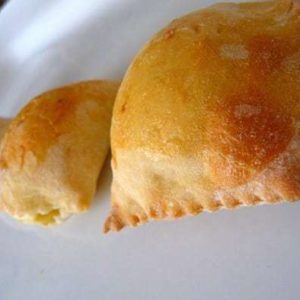
Pigu (Italian Gougères)
Ingredients
Dough
- 2 eggs
- 2 tablespoons cold water
- 1 teaspoon vegetable oil
- 1 cup (125 g) flour, plus more if needed (dough should be soft and elastic)
Filling
- 2 eggs, beaten
- 12 ounces (340.2 g) grated Romano, (¾ pound )
- Freshly ground black pepper, to taste
- 1 egg plus 1 tablespoon water for egg wash
Instructions
- 1. Preheat oven to 350 degrees F. Line a baking sheet with parchment paper or silicone mat, or spray with a non-stick baking spray.
- 2. Prepare the dough as you would a typical pasta dough, with a mound of flour with a well in the center. Into the middle break the eggs, add the water and oil, and mix together with a fork until combined and then begin incorporating the flour a little at a time. Once the dough comes together as a shaggy mass, knead it by hand until you have a soft, smooth, elastic dough. Add more flour or water, a small bit at a time, until that consistency is reached. Cover and set aside.
- 3. To make the filling, combine the eggs with the Romano cheese and black pepper in a medium bowl and stir until thoroughly combined.
- 4. Roll out the pasta dough to about 1/8-inch to 1/4-inch thickness. Place 1 tablespoon of the filling two inches apart across half of the rolled-out dough. When finished, fold the unused half the dough over the filling. Press around each mound of filling to release air and cut into squares with a knife or pasta roller. If using a knife, seal the edges with a fork. Place pigu on the baking sheet.
- 5. With a fork, beat together the egg and water and brush the tops of the pigu with the egg wash.
- 6. Bake for 10-15 minutes or until lightly browned.
Did you make this recipe?
Leave a review below, then snap a picture and tag @thebrowneyedbaker on Instagram so I can see it!


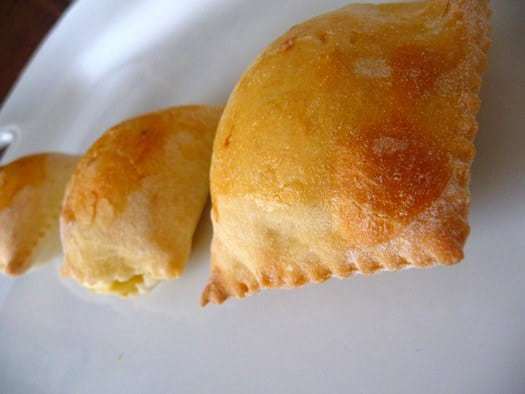
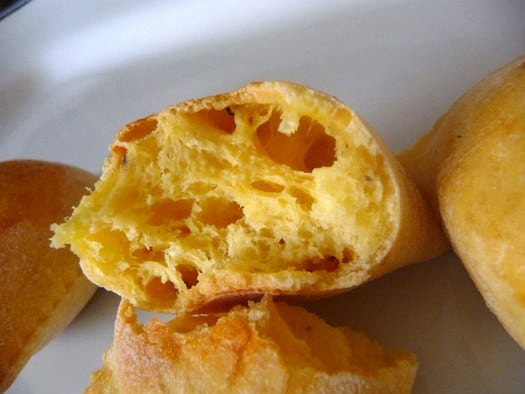
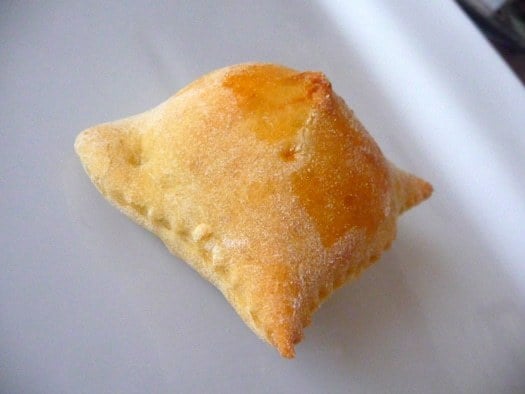
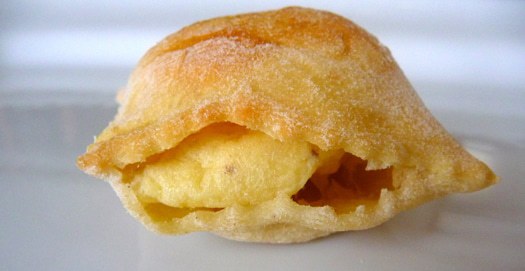



Hi, I’ve made these for years with my husbands parents recipe, very similar to yours but we add a heaping tablespoon of baking powder both parm and romano and snip tops. Yours is the first time every seen this recipe.
Hi , thanks for this recipe, Romano cheese is hard to find in my country ,i can use Parmesan ?
Hi Peri, Yes, Parmesan would work too! Enjoy!
Hi BEB! I made the pigus but they didn’t turn out at all like your photos. They were pretty much hollow inside and I still had about half the cheese egg mixture. Should I lessen the romano cheese amount and increase the eggs amount? I love the idea of them being like baked raviolis/gougeres. Help me please. I have tried many of your recipes and they have all been incredibly successful. This one seem to have me perplexed. Thanks!
I wouldn’t alter the amount of cheese/eggs in the filling. If the insides seem hollow, I would use more filling. They should pretty much be bulging with filling when baked.
These look great! I’ll be making them as soon as I have an oven (they don’t come standard in most Chinese houses). Can’t wait to hear what my boyfriend thinks; “pigu” is Mandarin for butt. Maybe I’m better off not telling him what they’re called until he tries them…
OK first of all I just wanna say I adore your blog and always have.
Now I have a question–I just made this recipe and found I had WAYYY too much filling, and I only ended up making about 12 pigu? What did I do wrong?
Hi Kayle, It sounds like you didn’t roll the dough thin enough; that would be the only reason I can think of that you’d get half as many pigu as you should with a lot of leftover filling.
That must have been it, totally wishing I had a pasta roller now!
What would you suggest serving these with? I’ve never heard of them and I would love to try them some time!
Hi April, We really don’t serve them with anything. We eat them as snacks, or munch on them before a holiday meal as an appetizer. Or, if you’re like me, make them breakfast :)
Hi there! I have never heard of pigu, but it looks delicious. Is it normally served as a main dish or as a side?
We eat them as appetizers and snacks, but they could be served with a meal as a side dish I suppose.
Ditto Chris… we also eat them as either appetizers or snacks. Enjoy!
For years, I have asked Italian cooks, and restauranteurs if they had ever heard
of pigus, and I have never found anyone. I even searched the internet many years
ago, and came up empty. I got the bug to find someone who had heard of
pigus, and again searched the internet, and this time found your page.
My grandparents are from Italy near Accumoli, just outside of Abruzzo. My grandmother
grew up in the states not far from Pittsburgh, in the small mining town of Wilpen.
I wasn’t sure if pigus were just something they made up, or if it came from Italy.
We make them a bit differently (my recipe is below), and be advised that the recipe
has likely changed a bit from the original as my grandmother had no written
recipes, and my mother wrote this down for me.
I wonder where the name Pigu came from? I wonder if this comes from something
pertinent to Pennsylvania, as I see that is where you are from as well as my grandmother?
I considered that it might be some variation of Pierogi, with which there is some similarity.
In any event, thanks so much for your publishing this, you made my day!
Here is our recipe. I’m leaving out the dough and directions, as it is only minimally different
than what you show, other than being twice as much.
Pigu
6 eggs (save 2 yolks for egg wash)
1 pound swiss cheese finely grated
1 cup Pecorino Romano finely grated (my grandmother once told me “never by Parmesean or Romano, nothing but Pecorino”)
1/2 pound ricotta cheese
pinch of cinnamon
pinch of cloves
salt
pepper
My mom notes that she starts with 5 eggs, mixes the rest together
and if it is too dry, she adds in the last egg.
Thank you so much for sharing your family’s pigu recipe! I am definitely going to save it and give it a try.
Hi!
This sounds absolutely delicious!! I can’t wait to try this recipe. Can you elaborate on how you “seal the edges with a fork”? Do you press it together and… yeah, I’m lost on that one.
Another question, Michelle: have you ever considered posting a recipe for pao de queijo? They’re basically Brazilian cheese bread… so balls of cheese bread. They’re absolutely delicious and I haven’t been able to find a decent one. Help me out? :)
Hi Natalie, Yes, you just press the tines of the fork down on the edges of the pastry to seal, much like a ravioli.
I have never heard of pao de queijo, but it sounds delicious! I will definitely do some research!
I have been looking for this recipe for 18 years – my gram made these all the time and I never had the recipe – it died with her! Thank you so much for FINALLY making it possible for me to make these!!!! Thanks!
Hi Liz, You can definitely make these ahead of time. They will keep at room temperature for quite a few days, so no problem! I hope you enjoy them, they are a family tradition and a favorite!
I would love to try this recipe out for my Pre-Thanksgiving Thanksgiving dinner I hold with my friends. Would this be a good appetizer that I can make ahead the night before and then just warm it up in the over before serving the day of?
I cannot wait to try this recipe out!! it sounds great!
hi! i’m Laura and i’m from italy. I have to say i totally love your website (both your recipes and photographs).
This kind of “ravioli” are called “fiadoni” and they are from Abruzzo, the region where i live. The are quite delicious with Pecorino cheese, which is one of the well-know Roma’s products.
P.s. Do you know a great pancakes recipe??? because i’m really in love with this kind of breakfast meal and i cannot find a good one.
(i’m sorry for my bad english :( )
EVENSONG — Yes, you can absolutely make them ahead and reheat them! I would just put the oven to “warm” or 200 degrees and put them in until warmed through. I should add, though, that I think these are just great at room temperature too!!
Is there any possible way I can make these ahead of time and reheat them?
Michelle… I absolutely LOVE you for publishing this recipe. My mother never gave me the recipe, and I’ve been missing these for years – they’re my favorite part of our Easter tradition! In fact, the last time I had them was when I made them with your grandmother a few years ago. She truly is one of my favorite little Italian ladies!!
And for anyone who has never tried them – they are like little pockets of heaven…
These look so tasty. I love the shots of the insides – you can tell how light they are. I keep meaning to try gougeres. Now you’ve inspired me to do so.
http://www.cookincanuck.com
They look soo good! Very flavorful with all the cheese.
Yum! These look and sound awesome. I’ll definitely try them! Great pics too :)
Oh, they look SO good! What a lovely family tradition.
Yum, these look and sound amazing! Thanks for sharing the recipe.
These look great Chelle!
looks good! they look so fluffy and tasty!
I’ve never had Pigu, but after seeing your pictures and hearing your description, I feel like I’ve totally been missing out. These look amazing, just amazing. Mmm, I wish I could have 10 right now. Delicious!
Those look amazing…I love how fluffy they are!
These are so cute and look delicious! I love ravioli – baked, toasted, boiled, so I’m sure I’d love these! Would you ever consider serving them with marinara sauce on the side, or would that ruin the concept? I’m from St. Louis where toasted (fried) ravioli is a big deal; it usually come with a red sauce for dipping.